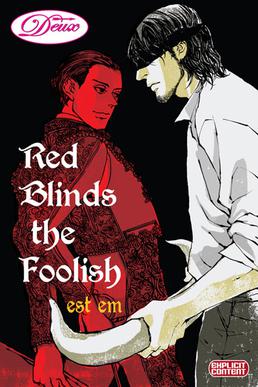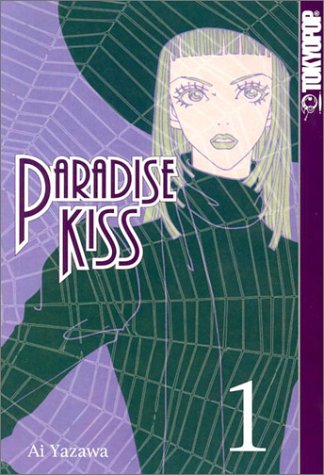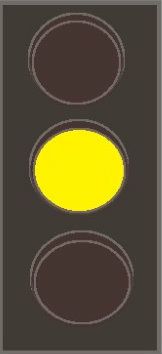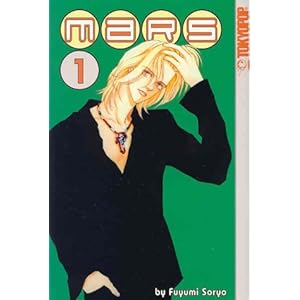Now, I am not afraid to admit that I do read and enjoy yaoi. I am also not afraid to admit that when it comes to yaoi, I am very particular about which ones I read, because sadly Sturgeon's Law applies to yaoi, i.e. that 90% of is awful.
Originally I was going to use this spot to review yet another work by Fumi Yoshinaga, who did quite a few one-shot yaoi stories before branching off into josei. I've already covered two of her works, though, so I decided to turn my focus on yet another underrated mangaka who is known for both BL and josei works: the unconventional (and uncapitalized) est em. She's getting a bit more exposure thanks to sites like JManga, but today I want to look at one of her previous, physically published works.
RED BLINDS THE FOOLISH (Oroka-mono wa Aka o Kirau), by est em. First published in 2008, and first published in North America in 2008.
PLOT: Rafita is the latest and greatest thing on the Spanish matador scene, famed for his brilliant red costume as well as his stoic and fearless performance in the ring. He soon takes up with Mauro, one of the butchers who processes the bulls that Rafita slays. Rafita treats their relationship as if it's no big deal, but soon Rafita starts to lose his nerve in the ring, and the cause may stem from Mauro. There are also stories about the soccer fan who meets up with the security guard who gave him quite the shiner in a mid-game brawl, a writer with an attachment to an old pair of red heels, and a writer taking down the story of an old man and his past as a choreographer for a French ballet dancer.
STORY: Red Blinds the Foolish is a breath of fresh air for anyone familiar with yaoi as a whole. It looks like no other yaoi on the market, it reads like no other yaoi on the market, and I am so very thankful that something like this exists.
Noteably, this isn't a single, linear story but an anthology of mostly unconnected ones. Secondly, they all feature an usual setting for manga - Europe (Spain, specifically). Admittedly, est em utilizes that setting rather shallowly. Sure, she incorporates elements like bullfighting and soccer, but she also seems to ignore the fact that Spain is a predominately Catholic culture, and as such there might be more conflict and concern for a gay man in Spanish culture, particularly one who is a prominent media figure like Rafita.
The volume is dominated by the title story, which is plot-wise the most complex as well as the artiest and most philosophical of the lot. Rafita starts as a cocky and somewhat shallow man, the kind who can stare down death even as it stampedes towards him or call his lover in the middle of screwing another man. By story's end, he has lost some of his fearlessness but has traded for some genuine concern and affection for Mauro. Mauro admittedly doesn't have quite as much of a character arc, although a bit of his backstory is filled in through one of the later chapters. He is sedate and calm, willing to wait things out and let Rafita figure things out on his own.
est em also doesn't linger too much on how anybody on this volume gets together. It simply just sort of happens somewhere offscreen (offpage?). I guess this does allow her to get past any of the characters' possible anxieties about whether the other party is gay, much less if they are into them, and it's an understandable shortcut when she doesn't have a lot of pages to spare. Still, it leaves these relationships feeling a bit uncomplete as even during sex the stories feel a bit emotionally cold. Mind you, part of that comes from the fact that we're mostly not seeing the complete arc of these relationships, but mere vignettes of their lives.
OK, so while her works are not perfect, there are a lot of good and cliche-defying things to say about Red Blinds the Foolish. First of all, for all of you out there sick to death of the whole seme/uke cliches? This is a manga for you. Here, none of the men are forced to fit any particular roles in the relationship (or in bed) beyond "significant other," "friend," or "associate." Secondly, these are all working adults - no high school kids, no college students, just god-to-honest grown up MEN. Third, she also doesn't force the sex into the story, as many a BL mangaka do to keep up audience interest. While she's not afraid of including sensuality in her work, she's not in it for the porn but instead for the characters and the relationships between them. It's more of a mature work in the sense of the writing and the sedate, intelligent tone versus being 'mature' in the 18+ sort of way.
While Red Blinds the Foolish is far from perfect, it's an interesting and mature collection of stories and it's a welcome spot of relief in the sea of hysterical ukes, aloof semes, and flowery sex scenes.
ART: est em also distinguishs herself from the crowd through her lovely, realistic artwork. Here her men look like actual, individual European men, instead of the highly stylized and feminized character designs one usually sees in yaoi. They have actual musculature! And butts! And even body hair! When was the last time you saw yaoi that acknowledge that men might have hair in places other than their heads?
There is a certain sketch-like quality to est em's art, particularly in the faces in closer shots or the sometimes hastily drawn details of Rafita's costume. Her backgrounds are often blank, although here this is not a detriment simply because est em frames every panel so beautifully and elegantly that you hardly mind - to add more to the panel would spoil the effect. There are a wide variety of simple, confident angles in the panels, along with some equally well-done intercutting of panels during moments of action (in every sense of the phrase *eyebrow waggle*). Overall there's a sense of confidence and simple beauty in the art which not enhances the tone of the story and goes a long way towards not only distinguishing est em from other BL mangaka, but from manga artists as a whole.
PRESENTATION: There are a couple of pages of author's notes about est em doing research for this volume, packed to the brim with notes and sketches. I did like the little touch of her drawing herself and her friend "C" as C-3PO and R2D2.
RATING:
 The look and subtlety of Red Blinds the Foolish more than make up for any faults it might have, and anyone who has ever been wary or weary of yaoi should give this and the rest of est em's catalogue a look.
The look and subtlety of Red Blinds the Foolish more than make up for any faults it might have, and anyone who has ever been wary or weary of yaoi should give this and the rest of est em's catalogue a look.This was published in the USA by Deux Press, and is currently out of print.
You can purchase manga like this and much more through RightStuf.com!
Well, it was certainly fun for once to focus on the good stuff for once. Next month promises to stuffed with even more reviews, as well as a very special giveaway. Come back this weekend to find out the details!








